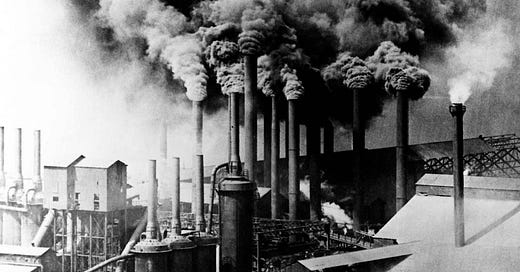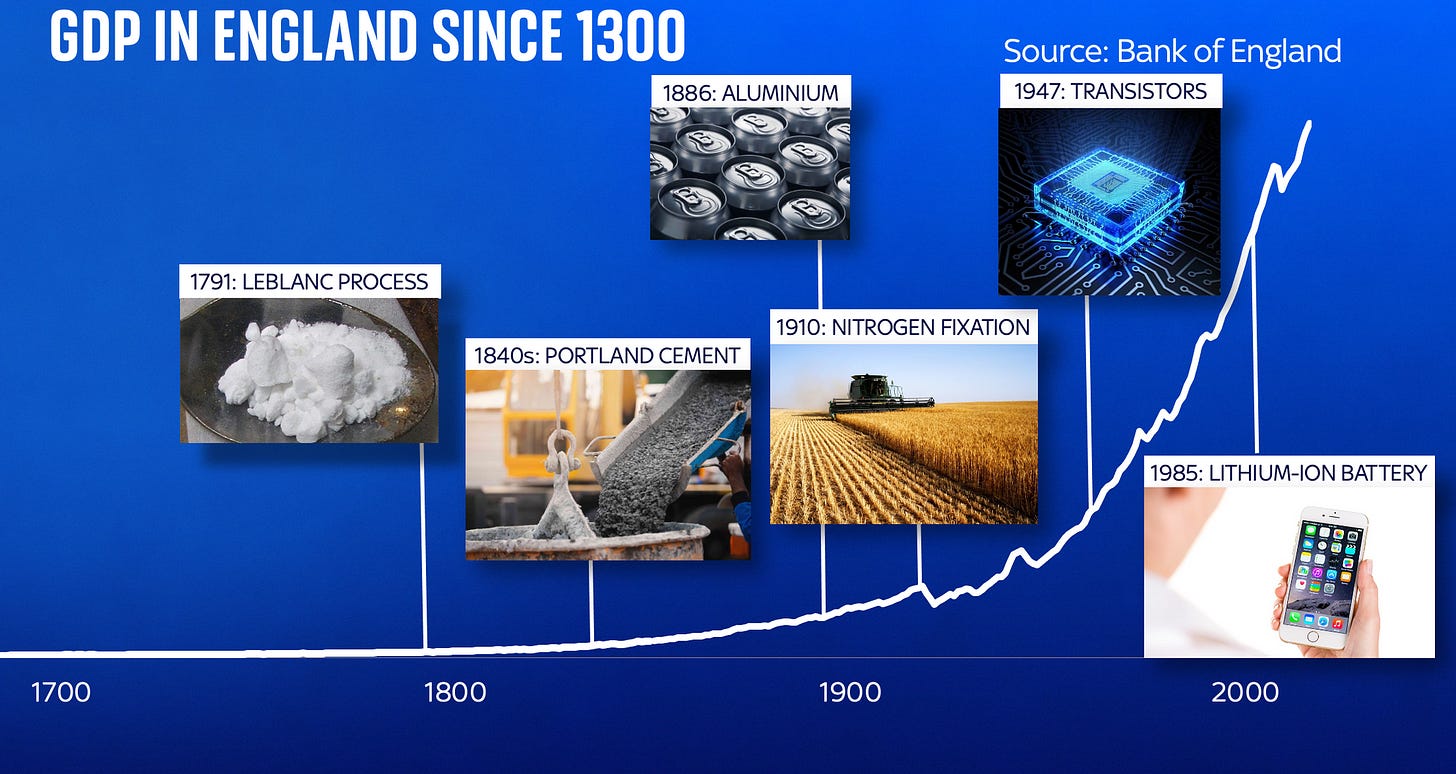Yet Another Industrial Revolution
The greatest challenge of the next decades isn't just making energy green; it's re-doing the Industrial Revolution all over again
Cards on the table, this is a re-post of something I wrote for my blog a couple of years ago. If you’ve already read it up there then feel free to ignore this. But while there will be plenty of original content coming up on this newsletter in the coming months, I thought in the meantime it might be useful to put a few older essays up here, partly because they help frame the subject matter of Material World and partly because I may end up linking to them occasionally in future newsletters - so we may as well keep some of these posts on the same platform to avoid confusion.
Economists are obsessed with the industrial revolution. And when I say obsessed I mean obsessed.
The more economic history you read (and I read quite a lot) the more you realise how much of it is really about the industrial revolution - even when those words are nowhere in the title. How did it happen, what did it involve, what were the consequences and, most of all, why did it happen where and when it happened, which is to say in Britain in the 18th and 19th centuries...?
And frankly, this obsession is fair enough. It is hard to think of another period in documented history which has had as profound and lasting an impact on everyone (I say “documented” because we know far less about the circumstances of the agricultural revolution, perhaps the main other contender in epoch-changing events). The obvious chart - and apologies if you’ve already seen it - is the hockey-stick one.
For all their flaws, gross domestic product statistics are still about the best proxy we have for giving a sense of people’s standard of living. And the story from this chart is pretty clear: for most of human history living standards barely improved from one generation to another. But then, following that critical period in the 17th and 18th century, they were catapulted ever higher.
And the striking thing is you could say the same thing about all sorts of other statistics on the human condition: life expectancy, a child’s chances of surviving birth and early years, global population, availability of food. Pretty much all these statistics had their own “hockey stick” moment in the years following the Industrial Revolution. So yes. This matters - big time.
The funny thing about books about the industrial revolution - which is, as we’ve established, means nearly every book about economic history - is how often they choose to view the period through a particular pet prism. For many it’s all about innovation and the enlightenment, for some it’s about capitalism and the profit motive, the nature of work, wages and how pay evolved; some say the Industrial Revolution and its origins was all about institutions; others say it was about natural resources; others still say it was really about energy and a transformation in our ability to get work done.
And of course the Industrial Revolution was about all of the above. But I want to pick up on something that’s occasionally forgotten amid all these histories, which often fixate on an economist or historian’s favourite topic.
The man who did most to popularise the idea of the Industrial Revolution was the Victorian historian Arnold Toynbee. In a series of lectures in 1884 he described the critical developments and innovations that took place in Britain over that period. The lectures are well worth reading but Toynbee’s account focused primarily on three things: textiles, steel and coal.
And fair enough, given these were among the most prominent industries and innovations which dominated much of the economy during this period. Britain’s textiles sector was truly world-dominant; the mass production of iron and steel helped birth countless other industries and helped build railways etc; the use of coal as a power source was utterly revolutionary.
And if you redraw that graph to include steel and textiles you can easily draw a line between them and the great leaps that followed. But here’s the thing. There was a lot of other stuff going on at the same time as well.
For instance, we rarely talk about the “chemical revolution” but during this very same period chemists were learning how to harness natural forces to convert one material into another. The Leblanc and Solvay processes were entirely revolutionary and allowed humankind to convert salt into soda ash - which in turn could be used to make soaps, papers and glass. The sanitary revolution - where in the late Victorian period cleaning products and sewers saved hundreds of millions of lives - was in part a product of this mostly-forgotten chemical revolution.
What about the concrete revolution and the race to discover cement? What about the invention of aluminium, one of the great discoveries of the late 19th century? What about the development of plate glass or the Haber Bosch process of 1910, without which we wouldn’t have the fertilisers which helped feed the world and averted those perennial (and perennially wrong) Malthusian predictions that we were going to run out of food? What about the invention of silicon chips (actually they were originally Germanium but that’s another story) in the 1940s, or the invention of lithium ion batteries in the 1980s?
The reality is there have been a panoply of different revolutions in industrial production over the past few centuries. The cliched, Dickensian vision of the Industrial revolution somewhat underplays the diversity of innovation that happened then - but continued to happen well into the 20th century.
But here’s the thing. Every one of the discoveries I’ve mentioned above has a dark side. Because each of these revolutions entails the creation of greenhouse gases. There is carbon dioxide created in the manufacture of Portland cement, of steel, of glass, in the making of most chemicals, in the production of nitrogen-based fertilisers, in the electrolytic reaction at the heart of the Hall–Héroult process that creates aluminium, in the refining of most metals, in the minting of silicon chips and solar panels and the making of lithium ion batteries. I could go on.
The point here is that if we want a truly zero carbon world we don’t just have to replace power stations. We have to re-imagine how to do all of those processes above that comprise centuries of innovation. We have to re-do the industrial revolution all over again. And, as you can see above, that means far more than just working out a way of making green steel.
I wonder if this has quite dawned on most people yet - the scale of the task at hand, the depth of scientific challenge that faces us. And this is before you consider the fact that we will eventually have to do all of this while relying ever more on sources of energy which are less dense and more intermittent than the fossil fuels we built the industrial revolution on. It is certainly the biggest economic challenge of any of our lifetimes.
Now in the very short run we might come up with ways of making good the continued emissions from the processes above. We can use greener power and perhaps offset some of the carbon dioxide. But the vague aspiration you often hear trotted out by the people doing the modelling is that all that offsetting is just a temporary means of getting us to this promised land, where we have eventually worked out zero carbon ways of making all of the above.
But, but… this is not easy. Not easy at all. Doable? Hopefully. But consider: what you see in that chart above is literally some of the most incredible technological leaps the human race has ever achieved. And we literally need to do it all over again. Not just that: unlike in the Industrial Revolution which was really spread out over centuries, we are aiming to do this in a matter of decades.
One view is that this is impossible. We are battling economic history, not to mention the laws of thermodynamics. But by the same token there is an opportunity here. If we are to reimagine these processes, to re-run the Industrial Revolution but sans carbon emissions it will necessitate one hell of an effort. Which leads to an alternative view: that the developed world has been in a productivity rut for so long, so perhaps this is the economic challenge that could kick-start it.
There is a tendency, in the face of climate change, to dismiss these kinds of considerations: as some might put it: why are we talking technicalities when we’re faced with a climate emergency? But these are not technicalities.
The very reason economic historians are still banging on about the Industrial Revolution even centuries on is that we are still living in the world it built - both from an economic and a social perspective. If one of the consequences of hitting net zero targets is to remake it all - to re-imagine the whole thing - well, that’s something we really need to talk about.








Hello, Couple of thoughts:
Agree with the premise - the sheer scale of reinvention required is greatly underappreciated - it's telling that the Knowledge newsletter sent me here rather than linked to an MSM article.
The task is likely harder because the new ways we need to make stuff are often not better in any other respect than being lower emissions, and will start off much more expensive. So the motivation to invent and for inventions to diffuse is limited without a clear emissions-reduction signal i.e. carbon price, which much of the world does not have. I suppose the (expensive) alternative is to subsidise the heck out of the new stuff as per the US "inflation reduction act".
I note that you didn't point out that we have an existing energy technology that can consistently produce plenty of emissions free heat and electricity using very dense energy sources...not trying to start the fight that normally occurs when the n-word is mentioned, but it does reinforce the value of being able to make use of this resource in a way that is both safe and perceived to be safe.
Finally the conventional economic wisdom is that it takes a few decades for productivity benefits to be obvious from major new technologies as it takes a while for people to get the best out of them and for existing structures and processes to be reoriented around them. So any new inventions tomorrow will start showing up in the productivity stats around 2050 when we are supposed to be hitting net zero...
If you're prioritising decarbonising industry you can focus on a few high impact sectors. 70-75% of industrial emissions come from the production of a few materials - steel, cement, fertiliser, plastics and aluminium.
Aluminium decarbonisation isn't hard since it's already an electrochemical process. You just need to change the anode and decarbonise the electricity source.
Fertiliser isn't that hard imo. Additionally electrochemical fertiliser production will massively decentralise production unlike what it is today which would reduce transportation costs (which are a big deal for fertiliser).
Steel and cement are the biggies. Most of their demand comes from construction. Fortunately since the majority of the cost of construction in high income countries is land, labour and permitting you can push the green premium for steel and cement for construction without that big of a loss in consumer surplus. This strategy will work in high income countries obviously and not low income countries.
In the next ten years countries should focus on decarbonising electricity, road transportation, residential and commercial heating, and low to mid temperature industrial heating (less than 200 degrees Celsius which makes 45% of all industrial heat demand). Fortunately for Europe, heat is much easier and cheaper to store for months than electricity.